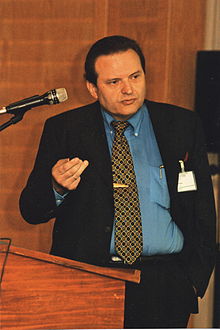Ludwig G. Strauss
Ludwig Georg Strauss (born July 5, 1949 in Worms ; † May 29, 2013 in Hesse ) was a German radiologist and university professor .
Career
Ludwig Strauss attended the Starkenburg-Gymnasium in Heppenheim and passed the Abitur there in 1968. At the Justus Liebig University in Giessen he studied human medicine from 1969 to 1975 and mathematics from 1973 to 1975. In 1975 he completed his medical studies and received his license to practice medicine in 1976. From 1975 to 1978 he worked as an assistant doctor for internal medicine . He received his doctorate in November 1978 with a thesis on the subject of "Comparative studies of various radio-in-vitro tests to assess thyroid function taking into account several parameters". Then he switched to the German Cancer Research Center and began his training in nuclear medicine (1978–1982). In October 1982 he became a specialist in nuclear medicine. He then moved to the Mannheim University Hospital , Institute for Clinical Radiology (Head: M. Georgi), where he completed his training as a specialist in the entire field of radiology in January 1986. In February 1986 he received his habilitation for the subject of clinical radiology with the subject “Quantitative and qualitative liver and spleen scintigraphy with single-photon emission computed tomography (SPECT) compared to transmission computed tomography (TCT)”. In 1987 he moved back to the German Cancer Research Center, Department of Oncological Diagnostics and Therapy (Head: Prof. Dr. G. van Kaick) and was responsible for the operation of one of the first whole-body positron emission tomographs (PET) in Germany. In October 1992 he was appointed adjunct professor for radiology at the Ruprecht-Karls-Universität Heidelberg . The oncological research in the field of molecular diagnostics with tomographic method was his primary area of research.
Scientific focus
Ludwig Strauss researched the use of new molecular imaging methods to improve oncological diagnostics as well as to optimize and individualize cancer therapy. He published numerous papers that propagated the use of PET. His work, The application of PET in clinical oncology , has been widely cited.
Private
Strauss' father was a doctor and ran a larger practice in southern Hesse. Since 1993 he was married to Antonia Dimitrakopoulou-Strauss, who also works as a professor at the German Cancer Research Center. They have a son together. Strauss still has two children from his first marriage. He died in 2013 after a long illness.
Web links
Individual evidence
- ^ LG Strauss, PS Conti: The applications of PET in clinical oncology . In: Journal of Nuclear Medicine . tape 32 , no. 4 , April 1991, ISSN 0161-5505 , pp. 623-648 , PMID 2013803 .
- ↑ of citations in Google Scholar
- ^ Antonia Dimitrakopoulou-Strauss, Ignasi Carrió: In memoriam: Ludwig G. Strauss, MD, 1949–2013. In: European Journal of Nuclear Medicine and Molecular Imaging. Vol. 40, 2013, pp. 1299 f., Doi: 10.1007 / s00259-013-2475-y .
| personal data | |
|---|---|
| SURNAME | Strauss, Ludwig G. |
| ALTERNATIVE NAMES | Strauss, Ludwig Georg |
| BRIEF DESCRIPTION | German radiologist |
| DATE OF BIRTH | July 5, 1949 |
| PLACE OF BIRTH | Worms |
| DATE OF DEATH | May 29, 2013 |
| Place of death | Hesse |
